Phoenix Contact Photovoltaic DC Stringbox

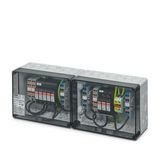

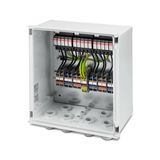
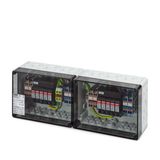






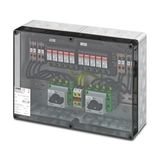


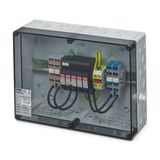

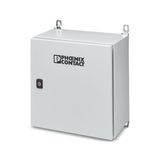
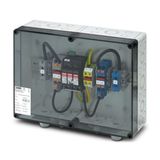
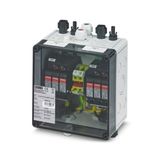
The challenge — why Phoenix Contact string boxes matter
In modern solar installations, the DC side isn’t just a handful of cables—it’s a network of parallel strings, high MPP voltages (often up to 1000 V or more), and the constant risk of over-voltages, fault currents, and service safety issues. Without reliable DC aggregation, monitoring and protection hardware, you leave system yield, maintenance cost and downtime on the table.
The Phoenix Contact DC string box (also called a string combiner box, junction/distribution box or DC isolator) resolves this by consolidating string inputs, safeguarding modules and inverters, and providing a gateway for monitoring.
Technology logic — how Phoenix Contact string boxes work
What the boxes do
- They collect multiple PV strings into one or more outputs feeding the inverter or downstream DC switchgear
- hey protect against over-voltage and surge events (typically Type T1/T2 SPD) to defend modules and electronics.
- They may include fuses, DC disconnect (fire-department switch), equipotential bonding and monitoring electronics
- They are designed for IP65 (or better) outdoor housings, wide ambient range (-20 °C … +55 °C) and for use with SUNCLIX or cable-gland entries.
Key specs to check
- Max MPP voltage: e.g., 1000 V DC typical in current models.
- String count: e.g., 2 strings, 4 strings, even 10 × 2 strings in larger boxes.
- Surge protection rating: Up ≤ 3.5 kV for T1/T2 SPDs.
- Housing/environment: IP65; material polycarbonate or polyester-reinforced, ambient designs.
Variants & Applications — Phoenix Contact fit for multiple solar use-cases
Rooftop commercial systems
For mid-size rooftop arrays you choose a smaller Phoenix Contact string box (e.g., 1–4 strings, up to 1000 V DC) with SUNCLIX connectors for rapid install. This suits limited footprint and easy service access
Utility-scale ground-mount parks
Here you’ll deploy larger boxes (e.g., 10 MPPT or more, multiple strings per MPPT) with full monitoring, high string counts, and robust surge/fault protection. Phoenix Contact offers portfolio for large-scale.
Hybrid or retrofit systems
If you’re upgrading legacy PV systems or combining storage, you might want boxes with embedded monitoring, wireless comms, and flexible entry options. Phoenix Contact supports custom configurations
Procurement & Design Criteria — what engineers and buyers must check
- Confirm system voltage rating: Is your array at 1000 V DC, 1500 V DC or beyond? Phoenix boxes list maximum MPP voltage.
- String count & MPPT mapping: How many inputs per tracker? Does the box support your inverter configuration?
- Protection scope: Surge protection (T1/T2), string fuses, DC disconnects — what’s required by your local fire code or insurer?
- Connection method: SUNCLIX vs. cable gland. For high-service or tool-free maintenance choose SUNCLIX; for large cables maybe glands.
- Housing environment: Will the box be exposed to UV, dust, water spray? Ensure IP65+, material, and mounting orientation match site conditions.
- Monitoring needs: If you need string-level current/voltage monitoring, look for models with Hall-effect sensors or wireless communication options.
- Certifications/compliance: Phoenix Contact string boxes comply with EN 61439-2 for switchgear assemblies
- Serviceability: Ensure spare modules, accessory kits and clear type-codes exist so you can maintain and repair units easily.
Operational Reliability & Maintenance — how Phoenix Contact keeps your array running
High system availability means fewer unplanned visits, faster fault detection, and safe servicing. Phoenix Contact string boxes help by:
- Offering monitoring that alerts you to string failure rather than reactive inspection.
- Enuring robust mechanical and electrical design (IP65, durable housing, SUNCLIX push-in) to handle outdoor PV conditions.
- Reducing downtime: Pre-assembled boxes mean faster install, less wiring error, fewer late-stage surprises.
- Supporting safe maintenance: DC disconnects + equipotential bonding + surge protection reduce risk during service or fire-department intervention.
Integration & Ecosystem — how Phoenix Contact fits your broader PV system
These string boxes do not work alone—they integrate smoothly into your array system:
- They match with Phoenix Contact connectors and combiners on the module side.
- They feed into inverter DC inputs or DC switchgear, enabling common vendor logistics.
- They can tie into monitoring/back-end systems for yield tracking, fault analysis and O&M workflows.
- Using the same vendor across combiner box + connectors + accessories simplifies spares, documentation and support.
Why Choose Bank of Lamps (Distributor)
- We provide genuine Phoenix Contact equipment with full manufacturer specifications and traceability.
- Our EU-based warehouse (Latvia) supports rapid order fulfilment across Europe.
- We offer B2B wholesale terms suited to large-volume procurement of Phoenix Contact components.
- We maintain real-time availability data on bankoflamps.com so project planners can lock BOMs with confidence.